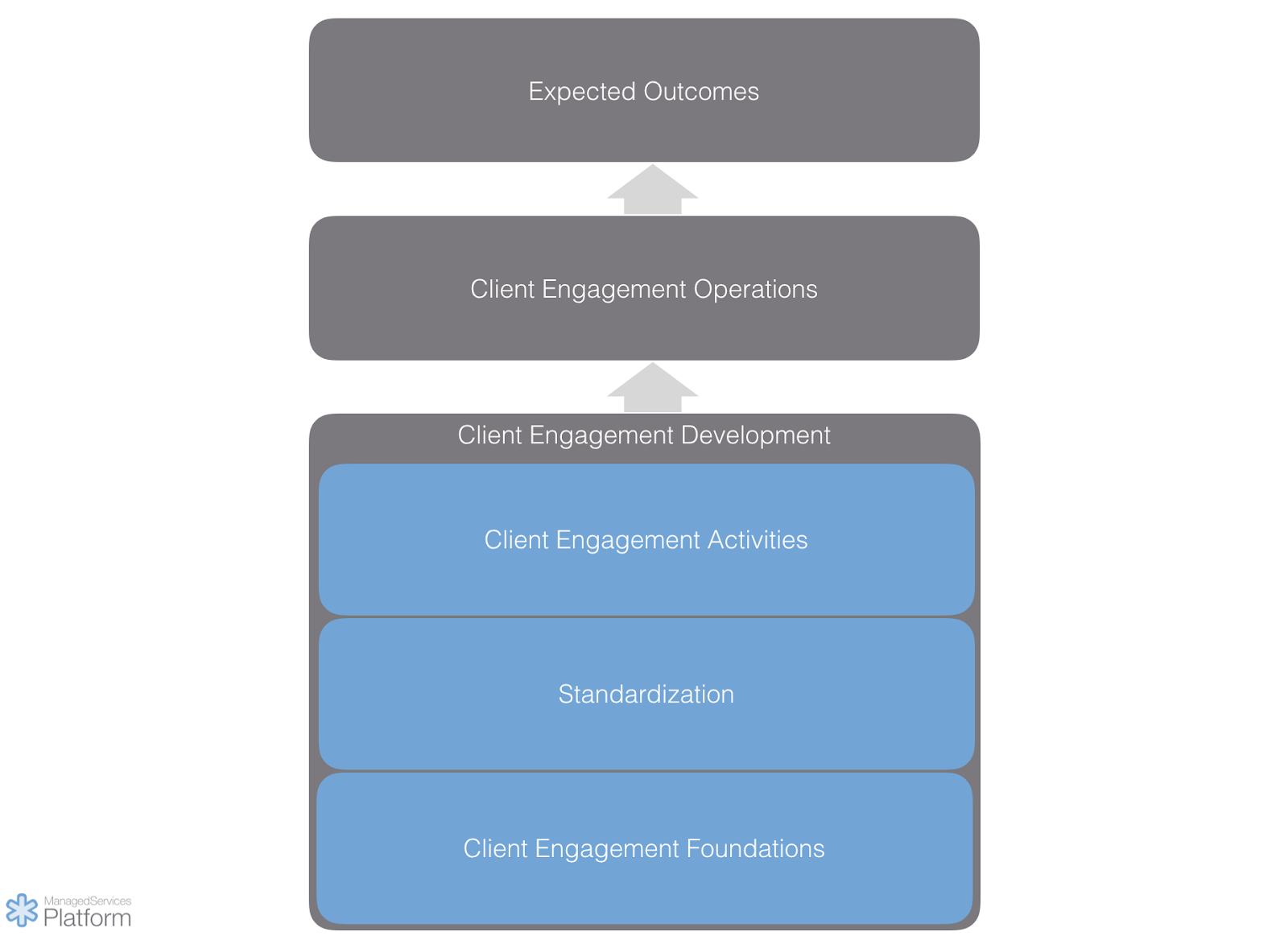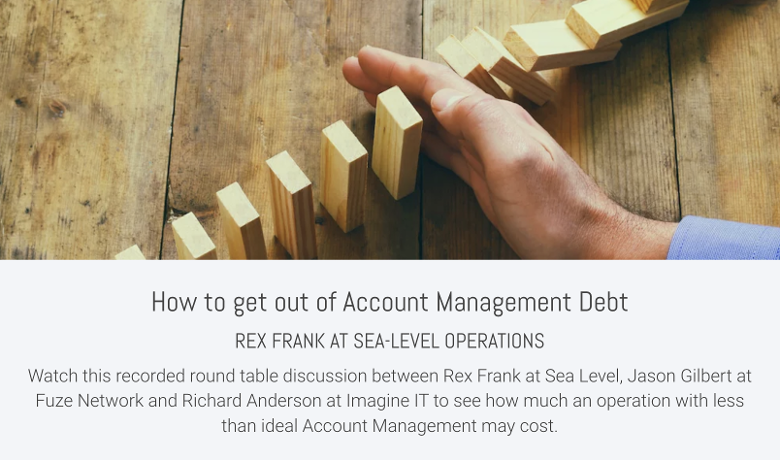
As a Technology Provider, you’ve undoubtedly encountered the symptoms of your clients' "Technology Debt." This is the manifestation of the inherent costs of perpetual support for less-than-optimal technology. This is a drain on both you and the client. Client Engagement Debt is a similar concept that encompasses the implied cost of not having enough quality Account Management, Technical Account Management, vCIO or IT Consulting activities with your clients. This costs you money, erodes trust, loses opportunities and even lowers the value your clients see in your services. Let’s take a look at how much debt you have and how to get rid of it this year.
STRUCTURE, MANAGE AND AUTOMATE YOUR ACCOUNT MANAGEMENT AND VCIO PROCESESS
7 Symptoms of Client Engagement Debt
Let’s cut to the chase and see whether you have Client Engagement Debt. The following list will provide symptoms of unhealthy Client Engagement Debt.
- Meetings are ad-hoc - meetings are set not well in advance but because of an issue, opportunity or client request
- Conversations are tactical - issues have piled up so the discussion is long and strategic topics go unaddressed
- Too much preparation time - there are no snapshots or baseline reports so conversations have to start from scratch every time
- Conversations are technology-focused - the lack of business discussions leads the meetings to technology discussions usually with non-executives
- There is no Strategic Governance - the quarterly meetings stand on their own and aren’t supported by a strategic roadmap
- The MSP owner is the only one who can do QBRs - the MSP owner is overtaxed with integrating all the missing pieces to present to a client
and this symptom is very tricky… as it presents as a great outcome of hard work..:
- Efficiency gains - reduced ticket count and efficient operation generate less natural facetime with a client. This is positive in general but it might relegate the MSP to a “low touch” partner role if there are no consistent proactive Account Management meetings in place.
Potential implications for different MSP size
Client Engagement Debt is not something that happens overnight because of a sudden issue or problem. Rather it’s a result of a slow eroding process of various inhouse and external factors.
External factors like technology commoditization, more millennials in the workplace, general technology adoption, tech savviness and the overall maturity raise the managed services market.
Internal factors like Account Management processes, quality of client meetings, time invested on client meetings, discussed topics, previous attempts of developing client engagement initiatives.
Here are the potential implications for MSPs of different size and maturity:
Small MSPs
If your company has less than 5-7 employees the chances are high that the owner is the only resource capable of delivering engaging client meetings. The obvious time pressure limits the resources available for developing programs or delivering quality interactions with proper follow-ups. The challenges are in streamlining the process and becoming more strategic with these conversations. This goes back to defining an Annual and a Quarterly process with clients, and support it with an application that helps the sharing of conversations and action plans.
Mid Size MSP
If your MSP has 8-20 employees the chances are high that there is a full-time individual responsible for Account Management and/or vCIO activities. The challenges at this point are related to accountability, scalability and a unified experience through the process. Properly set expectations for the client segments, proactive playbooks for activities, measurement of engagement as well as defined and adopted technology standards. These are the foundations of a process that will scale.
Large MSPs
If your MSP leadership were able to pass the 20 person mark then your 2nd layer of management should be in place and, due to your size, multiple people are responsible for different levels of client engagement. Account Managers, Technical Account Managers and vCIOs are working together as a team to drive client engagement. Now the challenges are more on the management and scalability side of the house. Processes, unified workflows, shared information, productivity and duplicate-able client meetings are the priority. As the team has to work together, a single QBR process might include 3-4 people in various roles to prepare a report, deliver the meeting and follow up all tickets, projects or opportunities. This leads to internal client engagement operation initiatives.
Regardless of the size of the MSP the real solution for managing Client Engagement Debt is similar to getting out of financial debt.. First create a momentum to start paying back the debt, then stabilize the operation to prevent future debt arising. That is why a holistic approach is needed rather than a quick fix.
Holistic Client Engagement Development
Let’s not go into the details too much here. If you feel you have these symptoms and are less engaged with your clients, you need to fix it soon. It’s critical because being an MSP is a “High-Touch” business model. Your foundation is a very close relationship with clients. In the past “Solving the IT Problems Together” created a natural bond with your clients. Now that you’ve been so successfully efficient you need different activities to maintain quality engagement.
Client Engagement Development has four components:

1. Client Engagement Foundations
Before we hit the road and cut the Client Engagement Debt we need to lay down the foundations of your Client Engagement.
Essentially, what is the level of Client Engagement your MSP wants to provide, who is going to provide it and what will comprise its requisite activities?
- Client Engagement Goals and Strategy
- Client Engagement Roles
- Client Side Roles
- Client Segmentation
- Client Segment Playbooks
2. Standardization
Once we have these foundations you have to define your standards. These standards are required to create an overall scoring of the technology health, applied best practices and technology stack adoption by your clients. These make the misalignments actionable for your team and standardize the operation, and will hugely attenuate ticket noise, as well as render the Account Management process easy and repeatable.
- General Standardization Strategy
- General Standardization Process
- Service Standardization
- Technology Stack Standardization
- Technology Best Practices Standardization
3. Client Engagement Activities
Now you can start establishing your client engagement activities. What is going to happen in the Annual Strategy Meeting, what will you do in the Quarterly Business Review Meeting, what types of Audits will you have (Cybersecurity, Infrastructure, Office 365) and so on. This is going to define the various activities you’ll provide to the distinct client segments you’ve defined.
- Technology Engagement Activities - Technology Roadmap Planning, Quarterly Business Reviews, Technical Audits etc.
- Business Engagement Activities - IT Strategy Planning, Quarterly Business Reviews, Business Workshops etc.
- Sales Engagement Activities - Renewals, vCIO Project Scoping, Consultative Sales Meetings
4. Client Engagement Operations
Parts 1-3 were about developing your Client Engagement - and now we move to execution. Now you need to manage your people (or your calendar if you are alone), schedule meetings with the right contacts, manage meetings and generate and maintain client roadmaps for governance. This part is about efficiency: less time in preparation, more effective conversations, and productive handoffs to the delivery team. Here’s where we are going to learn how to run an effective client engagement operation.

Your Reward: Client Engagement Excellence and Account Management Dividends
Client Engagement Activities done well reduce your Client Engagement Debt and prevent future Debt happening.
- You run an efficient, profitable operation by adopting technology best practices, a unified solution stack, and well-defined services.
- Your clients are better engaged, value your services more highly, feel they’re getting what they’re paying premium rates for and generate sustainable growth for you.
- You can differentiate your brand and demonstrate your value to your clients.
Without a strategic effort, your next Client Engagement initiative will likely stall and never take off for scalability. Let’s do it right this time.


